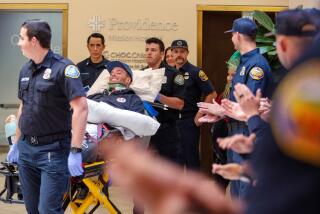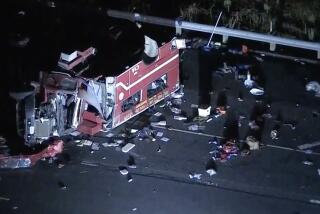Tragic Accident Puts Trauma Teams to Test
It began at 6:45 p.m. Thursday--a major traffic accident, with two people dead and 23 injured, in the barren “no man’s land” just south of the San Clemente Border Patrol checkpoint.
Before it was over, three helicopters and eight ambulances, including a military ambulance from Camp Pendleton, had ferried victims to six hospitals in San Diego and Orange counties.
The accident put trauma systems in both counties to the test. And there were some snags: Gridlocked traffic blocked ambulances trying to reach the accident scene. An Orange County emergency radio network went into operation half an hour late and could not be heard by a San Clemente hospital. And it took from one to two hours to get some critically injured patients to the nearest trauma center.
But despite these problems, the system generally seemed to work well, officials from both counties said Friday. “Patients were appropriately spread out (to different hospitals). Though it was two counties and many agencies, it went fine,” said Betty O’Rourke, program director of Orange County’s emergency medical services.
Gail Cooper, chief of emergency medical services in San Diego County, agreed: “You had two federal agencies, a state agency, two different county agencies and a city--all working together.”
Among those involved were the U.S. Border Patrol, the California Highway Patrol, Orange County’s communications agency, a San Diego County sheriff’s helicopter, an ambulance crew from Camp Pendleton, three private ambulance companies and paramedics from San Clemente.
The medical response was coordinated at the accident scene by Linda Nunez, a veteran flight nurse with Lifeflight, UC San Diego Medical Center’s emergency helicopter service. Nunez, initially flown in to treat patients, became a scene commander, evaluating the conditions of the victims and routing the most seriously injured by helicopter to trauma centers in Mission Viejo, La Jolla and San Diego.
“It’s everyone’s nightmare to go to one of these,” Nunez said Friday. “But I was really pleased with the way everyone reacted.”
Marty Bennett, chief flight nurse for Lifeflight, was aboard the third helicopter to arrive on the scene, landing a little more than an hour after the accident. By that time, she said, “everything was extremely well-organized.” The crew was directed to two patients who had been designated for Scripps Memorial Hospital in La Jolla, and they were back in the air in about 20 minutes, she said.
In Orange County, an emergency system called Hospital Emergency Administrative Radio (HEARNET) asked all 38 hospitals in the county to “stand by” for accident victims.
But there were several problems with the emergency radio network, said Marcia Thompson, chief of operational support for Orange County Communications, a public safety agency.
San Clemente General Hospital officials said that its reception was fuzzy and that they eventually gave up on the network altogether, instead communicating with dispatchers by phone.
Another problem with HEARNET was administrative. Under the Orange County trauma plan, officials at UCI Medical Center are supposed to run HEARNET, tracking the number of vacant hospital beds and doctors available at each hospital and directing accident victims to the closest facility.
But “there was some misunderstanding” Thursday night, Thompson said. A doctor at the medical center apparently did not understand HEARNET procedures and did not respond to Orange County Communication’s request to activate the system, she said.
Finally, at 8:37 p.m., after a 30-minute delay, Orange County communications Sgt. Linda Bomberg took over, broadcasting the alert. Thompson called the HEARNET problem “probably more of a small annoyance” than a major breakdown. “The system can run without them (UCI Medical Center),” she said.
At the medical center, administrative analyst Tim Ogata said, “Our performance was sub-optimal,” and officials there were investigating what had happened.
The traffic accident occurred when a tractor-trailer truck plowed into a van, causing a chain-reaction crash involving several other vans on northbound Interstate 5. At least five of the injured were trapped in their cars, California Highway Patrol Sgt. Bill Starnes said.
Starnes, who is based in Oceanside, said that fire department paramedics and private ambulances responded quickly. “But the problem was the motoring public. The freeway was at a standstill northbound. There was no way to get paramedics to the scene.”
With traffic stopped dead, some motorists parked in the freeway’s center divider and on the right shoulder, Starnes said. Eleven CHP officers tried to clear a path for emergency vehicles on the right-hand shoulder by getting out of their cars and wading through traffic, he said.
“But once we cleared it up, other people would pull over and block it again,” Starnes said, adding that it took at least 20 minutes for the first ambulance to get through.
That unit, a Hartson’s Ambulance based in Oceanside, arrived shortly after 7 p.m. and its two emergency medical technicians were immediately “overwhelmed,” Hartson’s operations coordinator John Reisdorfer said. “They were inundated with so many patients--so much to do,” he said.
The Lifeflight helicopter bearing Nunez, nurse Mike Epperson and a pilot arrived at 7:14 p.m., a Lifeflight supervisor said, and the second Lifeflight helicopter arrived at 7:53 p.m., landing just behind a helicopter from Orange County.
San Clemente General Hospital was already treating five traffic victims from two unrelated minor accidents when it learned about the mass accident near the border checkpoint at 7 p.m., emergency department coordinator Vicki Sweet said.
The hospital immediately called in two more doctors, Sweet said. Initially the 116-bed community hospital, which is not a designated trauma center, was warned that it might receive as many as 20 patients, Sweet said, but at about 8:30 p.m., four patients were brought in, two reported in critical condition Friday.
Lifeflight delivered two of the most seriously injured patients to Scripps Memorial Hospital, the La Jolla trauma center that is designated to serve the Oceanside area, at 8:47 p.m.--two hours after the accident, a Lifeflight official said.
Dr. Brent Eastman, Scripps director of trauma, called that two-hour period “indeed a long time” for patients to wait to receive treatment. The average time from an accident scene to a San Diego County trauma center is 11 minutes, Eastman said, “But you have to put that in the context of what happened--the congestion, the extrication, the mass of trauma at the scene. . . . Considering that, I think the system was working well.”
Another Lifeflight helicopter delivered two injured women to Sharp Memorial Hospital in San Diego at 9:07 p.m. Though the hospital activated its trauma team, the women were not seriously injured, said trauma nurse Joan Anders. One had chest pains and the other had injuries to her limbs. Again, at 9:35 p.m. and at 10:03, three more patients with minor-to-moderate injuries arrived at Sharp by ambulance, Anders said. One of those remained hospitalized Friday but the other two were treated and released.
Ambulances brought three patients to Tri-City Hospital in Oceanside at about 8:30 p.m. One of them was hospitalized with a broken leg, and the others were treated and released, spokesman Wayne Russell said.
“We did not call in extra surgeons. The extent of the injuries did not warrant that,” Russell added.
One of the busiest hospitals Thursday night was Mission Hospital Regional Medical Center in Mission Viejo, a 212-bed facility and regional trauma center that received seven patients in all--the most of any hospital.
Using its public address system, the hospital at 8:22 p.m. announced that it was on “Code Triage” emergency status. Actually, that announcement came a few minutes after the hospital received its first critically injured patient by Med-Air, an emergency helicopter service run by Western Medical Center in Santa Ana, said Paul Russell, co-chairman of the hospital’s disaster plan. The injured man immediately underwent surgery for leg fractures, Russell said.
An hour later, at 9:25 p.m., two ambulances loaded with six accident victims pulled up to the emergency room doors. But the hospital was ready for them. Russell said.
By then, its 20-member trauma team was working, another 15 nurses had been asked to return to work and the hospital had beefed up its entire staff, from intensive care to housekeeping, Russell said.
When the two ambulances arrived at once, “it was confusion, but it was organized confusion,” Russell said. Most of the victims, Dutch entertainers who had suffered bruises, spinal pain and other minor injuries, spoke English, Russell said, but the hospital also located one of its engineers, Pieter Huizer, who could speak Dutch and helped calm them.
“When they first came in, the anxiety mode was on the ceiling, but Pieter communicated with them,” Russell said.
The mood became confused again when Jof Richares, who has been a patient with minor injuries, suffered a heart attack as he was being discharged. He was immediately treated in the hospital’s cardiac catheterization lab, Russell said, and the staff returned to its activities. Richares died Friday.
Russell said that Mission called off its “Code Triage” at about 11 p.m., but its work was still not done. Because Mission had received the largest number of victims, its emergency room became a center where those treated at other hospitals rejoined their friends, Russell said.
More to Read
Sign up for Essential California
The most important California stories and recommendations in your inbox every morning.
You may occasionally receive promotional content from the Los Angeles Times.









